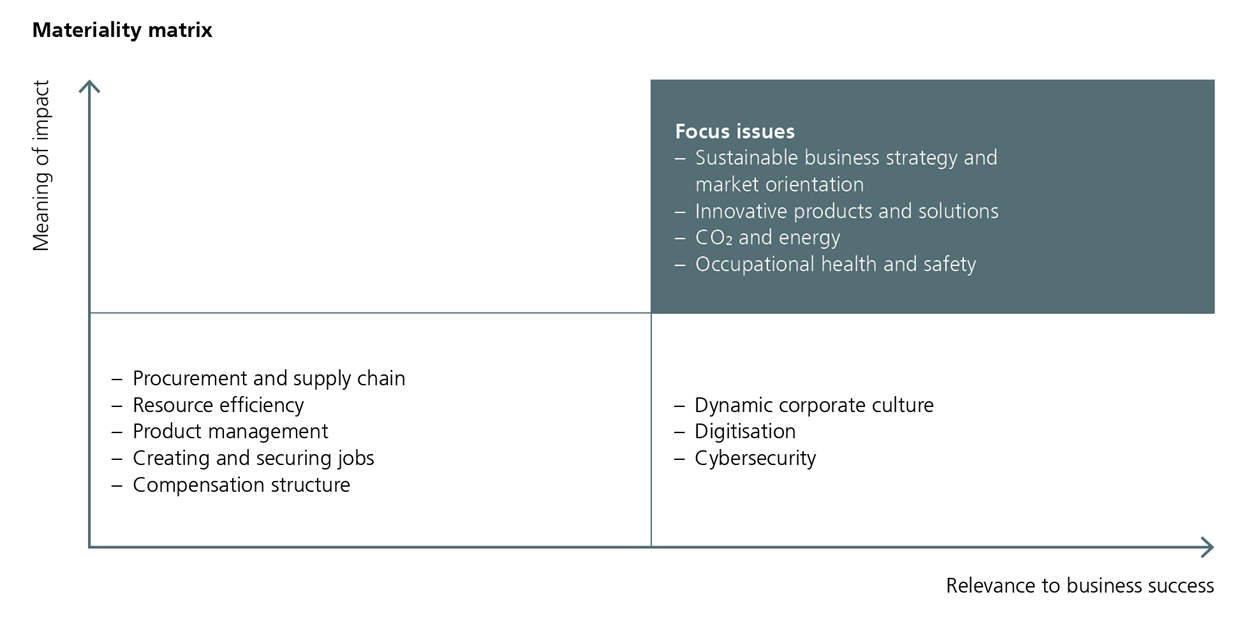- Sustainability approach
- Sustainability strategy
- Sustainability governance
- Materiality analysis
- Ethics and integrity
- Risk management
- Stakeholder engagement
Sustainability approach
Arbonia is convinced that conscientious action and responsible treatment of employees, suppliers, customers, and investors, as well as the environment and resources, are essential for the long-term success of the business.
Arbonia's sustainability strategy is divided into the three subareas of "Climate", (ecological issues), "Community" (social issues), and "Cash" (economic issues). In these areas, the company wants to continually optimise its sustainability performance beyond the legal requirements.
Sustainability strategy
Arbonia takes the approach of responsibly creating (added) value from raw materials. The consistent focus on a sustainable and long-term business model has brought changes in recent years. Arbonia makes investments with the objective of making both its product portfolio and its production processes even more sustainable. In addition, it supports agreements to reduce greenhouse gas emissions such as the "Paris Agreement" of the Paris Climate Conference and the "European Green Deal" and actively contributes to minimising global warming. For this purpose, Arbonia defined the first CO2 reduction targets for its emissions from Scope 1 and Scope 2 in the reporting year, based on the Science Based Targets Initiative (see "CO2 and energy", p. 52).
The sustainable Group strategy is practised in the entire corporate group and supported by the Board of Directors. This is also demonstrated by joining the United Nations (UN) Global Compact, which was initiated in the reporting year. Since the beginning of the year, the Arbonia Group has officially been a member of the UN Global Compact.
In addition to the central coordination and definition of targets, the two divisions HVAC and Doors have a high degree of responsibility due to their decentralised organisation. They develop specific plans to support and implement the group-wide sustainability strategy and to expand the product portfolio.
Sustainability governance
Arbonia has a decentralised structure. Group Management – consisting of the CEO, CFO, and the division heads – defines the measures to implement the strategy set by the Board of Directors. The responsibility for the operational business lies with the divisions.
Sustainability is part of the Group strategy set by the Board of Directors. Management of the topic within the Group is the responsibility of the CFO of Arbonia. The CFO develops the sustainability strategy together with the Sustainability Committee and representatives of the department of corporate communications & investor relations, which is responsible for the Group-wide coordination. The Sustainability Committee consists of a representative of the HVAC Division and one representative each from the Wood Solutions Business Unit and the Glass Solutions Business Unit of the Doors Division. The implementation as well as the derivation of measures is the responsibility of the divisions or their companies in consultation and coordination with the Group. Group Management discusses and evaluates the most important initiatives and projects on a monthly basis. Arbonia's Board of Directors is responsible for the decision-making and control of all measures as well as the assessment of performance in line with defined goals.
Materiality analysis
The present second sustainability report of Arbonia is based on a materiality analysis that was carried out in 2020. In this analysis, Arbonia determined which issues are relevant for long-term business success and with which issues the group has a significant impact on the environment and society. The materiality analysis was carried out on the basis of a wide spectrum of contents that included the criteria of ESG rating agencies and the orientation of similar companies, in addition to issues of the Global Reporting Initiative (GRI) standards and the Sustainability Accounting Standards Board (SASB). Related topic areas were first consolidated in a core team. Afterwards, the relevance of the topics was evaluated in a workshop – by representatives of the two divisions, HVAC and Doors, as well as by various corporate functions (e.g. Human Resources and Legal & Compliance). This process was supported by an external specialist, and the result of the analysis was mapped in the following materiality matrix:
Ethics and integrity
Arbonia is aware of its economic, ecological, and social responsibility and is committed in its code of conduct 1.) to respecting human rights, especially taking into account the prohibition against child labour, 2.) to ensuring the occupational health and safety of its employees, 3.) to cooperating with suppliers who meet their obligation to sustainability and social responsibility, 4.) to observing environmental protection standards, and 5.) to using resources carefully.
Code of Conduct
The Board of Directors last revised the code of conduct in 2018. The code of conduct has been translated into thirteen languages and is available on the Intranet for all white collar employees. The code of conduct is supplemented by further instructions, such as the anticorruption instruction, the instruction concerning insider trading, the instruction for protection against sexual harassment, bullying, and discrimination at the workplace, and many more. In the reporting year, Group Management also issued a Group-wide water policy and waste policy that went into effect on 1 January 2022.
All employees sign the code of conduct upon joining the Arbonia Group and commit to observing the values as well as the ethical and social principles of the Arbonia Group.
In addition to the code of conduct, the Board of Directors issued the "Supplement to the Code of Conduct", which is specifically directed to blue collar employees, in 2018. The "Supplement to the Code of Conduct " contains more in-depth topics and regulations for production – for example, on dealing with resources, on occupational safety, or on environmental protection. It does not include specific topics such as competition law. The "Supplement to the Code of Conduct" is displayed on posters in the production halls and taught by the plant or shift managers.
Whistleblowing concept
The participation of employees is of critical importance for compliance with the Code of Conduct, including the "Supplement to the Code of Conduct" (collectively referred to as "Code of Conduct" in the following). For this reason, the Board of Directors introduced reporting offices for whistleblowing in 2013. All employees who learn of violations of the code of conduct are requested to report these either through the regular official channels or to one of the three reporting offices. A central element of the whistleblowing concept is to protect reporting employees. Whistleblowers must not be subjected to any disciplinary, legal, or other measures to their detriment as a result of their reporting.
The Board of Directors is informed in detail about all whistleblowing reports, the corresponding clarification results, and initiated measures.
Against the background of the new EU Directive on the protection of persons who report breaches of European Union law ("EU Whistleblowing Directive") and its implementation in various national legislation, Arbonia will review its whistleblowing concept in 2022 and make adaptations as necessary.
Code of Conduct training courses
White collar employees regularly take part in code of conduct training courses. These training courses discuss all the core topics of the code of conduct and go into greater depth on individual, more detailed instructions. The topic of whistleblowing is part of the code of conduct training. The employees are shown where they can make whistleblowing reports and what the further procedure is after a report has been received.
In the reporting year, preparations were made to survey the knowledge of white collar employees on the code of conduct in 2022 via an electronic learning platform.
Risk management
The risk management process of Arbonia has been institutionalised for some time and is as follows: Once every three to five years, the risk catalogue is redefined from the bottom up and the top down on the level of business units, divisions, and the Group using a greenfield approach. In the other years, the existing risks are checked and adjusted if necessary, and additional risks are continually identified. The risk catalogue comprises strategic, operative, financial, economic, as well as external risks and forms the basis for the risk analysis workshops, which take place on the Group as well as the division level with independent, external support.
The workshops are designed so that a wide and varied circle of responsible people participate in them (generally eight to twelve participants per workshop). In the first step, the central changes compared to the previous year are discussed and integrated into the risk catalogue in the workshop. In the second step, the participants assess the risks in relation to the extent of damage, probability of occurrence, and effect on reputation. In addition, they discuss and define the cashflow relevance and the risk-reward ratio. This results in a corresponding risk matrix and associated expected values of the risks, which are finally discussed in comparison to the previous year and checked for plausibility in the group. After the workshops, the risk owners define how to handle the risks or determine appropriate measures for risk reduction within a defined period of time. These measures are reviewed and updated half-yearly.
The results from the workshops are aggregated over all divisions (bottom up) and a comparison is made with the Group (top down). Group Management then discusses and adopts this assessment and quantification of the risks together with the measures for the top risks before they are submitted to the Audit Committee and the Board of Directors.
Stakeholder engagement
Arbonia maintains an extensive exchange with all stakeholders that have a significant influence on the economic, ecological, and social goals of the company. This group of internal and external stakeholders includes customers, employees, shareholders and investors, analysts, public authorities, neighbours, and communities at the company locations – as well as partners such as transport companies, suppliers, research institutes, and associations as well as the general public. The communication with these groups takes place in the framework of personal discussions, meetings, conferences, and trade fairs, as well as surveys. The table "Inclusion of stakeholders and their concerns" gives an overview of the dealings with the individual stakeholders.
Membership in the most important chambers and associations – including Swissmem (association of the Swiss mechanical, electrical, and metals industry), SwissHoldings, Thurgau Chamber of Commerce and Industry, the employer's association, the German Federal Association of Building Systems, and the German-Swiss Chamber of Commerce – allow Arbonia continuous communication with companies in related sectors and relevant interest groups. In 2021, Arbonia also initiated the accession to the UN Global Compact and will publish a communication on progress for the first time in the following year.
Arbonia is consistently committed to the communities at its production sites. For example, there are numerous donation programmes and supports for non-profit organisations at Arbonia. Many of the companies promote sports activities for youth and adults. The companies of Arbonia are also involved in some financing activities for scholarships to technical colleges. One company sponsored protective masks for senior citizens in Ciasna (PL) in conjunction with the COVID-19 pandemic. The company in Prüm (D) collected donations after the flood disaster in July 2021, supplemented them, and distributed them to the affected region.
Inclusion of stakeholders and their concerns

